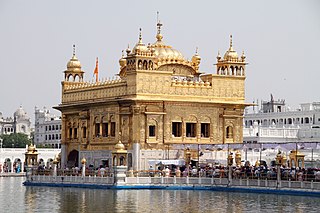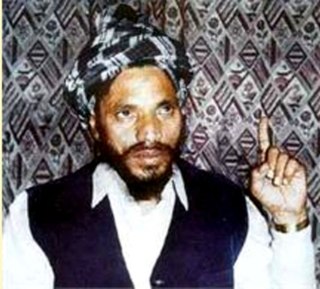
Sikhism, also known as Sikhi, is an Indian religion and philosophy in particular for the Sikh ethnoreligious group that originated in the Punjab region of India around the end of the 15th century CE. The Sikh scriptures are written in the Gurumukhi script particular to Sikhs. It is one of the most recently founded major religious groups and among the largest in the world, with about 25–30 million adherents.

Guru Gobind Singh was the tenth and last human Sikh Guru. He was a warrior, poet, and philosopher. In 1675, at the age of nine he was formally installed as the leader of the Sikhs after his father Guru Tegh Bahadur was executed by Emperor Aurangzeb. His father was the ninth Sikh Guru. His four biological sons died during his lifetime – two in battle and two executed by the Mughal governor Wazir Khan.

The Guru Granth Sahib is the central holy religious scripture of Sikhism, regarded by Sikhs as the final, sovereign and eternal Guru following the lineage of the ten human gurus of the religion. The Adi Granth, its first rendition, was compiled by the fifth guru, Guru Arjan (1564–1606). Its compilation was completed on 29 August 1604 and first installed inside the Golden Temple in Amritsar on 1 September 1604. Baba Buddha was appointed the first Granthi of the Golden Temple. Shortly afterwards Guru Hargobind added Ramkali Ki Vaar. Later, Guru Gobind Singh, the tenth Sikh guru, added hymns of Guru Tegh Bahadur to the Adi Granth and affirmed the text as his successor. This second rendition became known as the Guru Granth Sahib and is also sometimes referred to as the Adi Granth.

Guru Har Krishan was the eighth of the ten Sikh Gurus. According to Dr Harjinder Singh Dilgeer, Guru Harkrishan was born on 20 July 1652. At the age of five, he became the youngest Guru in Sikhism on 7 October 1661, succeeding his father, Guru Har Rai. He contracted smallpox in 1664 and died before reaching his eighth birthday. It is said that he died because he contracted smallpox while successfully curing his followers.
The following outline is provides an overview of Sikhism, or Sikhi.

The Dasam Granth is a collection of various poetic compositions attributed to Guru Gobind Singh. The text enjoyed an equal status with the Adi Granth, or Guru Granth Sahib, in the eighteenth and nineteenth centuries and were installed side by side on the same platform. The Dasam Granth lost favor during the colonial period when reformist Singh Sabha Movement scholars couldn't contextualize the reworkings of Puranic stories or the vast collection of 'Tales of Deceit' Sri Charitropakhyan.

The Nihang or Akali, also known as Dal Khalsa, is an armed Sikh warrior order originating in the Indian subcontinent. Nihangs are believed to have originated either from Fateh Singh and the attire he wore or from the "Akal Sena" started by Guru Hargobind. Early Sikh military history was dominated by the Nihang, known for their victories where they were heavily outnumbered. Traditionally known for their bravery and ruthlessness in the battlefield, the Nihang once formed the irregular guerrilla squads of the armed forces of the Sikh Empire, the Sikh Khalsa Army.

Piara Singh Bhaniara also known as Baba Bhaniara, was a Dalit religious leader from Punjab, India. He established a breakaway Sikh sect in the 1980s, which was opposed by orthodox Sikhs as insulting to their faith. In 2001, his followers published their own holy text Bhavsagar Granth, and allegedly insulted the Sikh holy book Guru Granth Sahib. This sparked violence against Bhaniara's followers. The Government of Punjab banned Bhavsagar Granth, and arrested and jailed Bhaniara.

Anandpur Sahib, also referred simply as Anandpur, is a city in Rupnagar district (Ropar), on the edge of Shivalik Hills, in the Indian state of Punjab. Located near the Sutlej River, the city is one of the most sacred religious places in Sikhism, being the place where the last two Sikh Gurus, Guru Tegh Bahadur and Guru Gobind Singh, lived. It is also the place where Guru Gobind Singh founded the Khalsa Panth in 1699. The city is home to Takhat Sri Kesgarh Sahib, the third of the five Takhts in Sikhism.

The Takht Sri Darbar Sahib Damdama Sahib, is one of the five takhts or Seat of Temporal Authority of Sikhism, located in Talwandi Sabo, near the city of Bathinda in Bathinda district of Punjab, India. At this place Guru Gobind Singh, the tenth Sikh Guru, prepared the full version of the Sikh scriptures called Sri Guru Granth Sahib in 1705. The other four Takhts are the Akal Takht, Takht Sri Keshgarh Sahib, Takht Sri Patna Sahib and Takht Sri Hazur Sahib.

Chamkaur Sahib is a Sub Divisional town in the district of Rupnagar in the Indian State of Punjab.

Nanakpanthi, also known as Nanakshahi, is a Sikh sect which follows Guru Nanak (1469-1539), the founder of Sikhism.
Followers of Sikhism do not have a preference for meat or vegetarian consumption. There are two views on initiated or "Amritdhari Sikhs" and meat consumption. "Amritdhari" Sikhs can eat meat. "Amritdharis" that belong to some Sikh sects are vehemently against the consumption of meat and eggs.

Hazur Sahib, also known as Takht Sachkhand Sri Hazur Abchalnagar Sahib, is one of the five takhts in Sikhism. The gurdwara was built between 1832 and 1837 by Maharaja Ranjit Singh (1780–1839). It is located on the banks of the Godavari River at the city of Nanded in the state of Maharashtra, India.
A takht, or taḵẖat, literally means a throne or seat of authority and is a spiritual and temporal centre of Sikhism. There are five takhts, which are five gurudwaras that have a very special significance for the Sikh community. Three are located in Punjab whilst the remaining two are located outside of it.
Lohgarh is a historic town in Bilaspur tehsil of Yamunanagar district of Haryana in India. It was the capital of First Sikh State under Baba Banda Singh Bahadur from 1710 to 1716.

Guru Nanak Jhira Sahib is a Sikh historical shrine situated in Bidar, Karnataka. Gurdwara Nanak Jhira Sahib was built in 1948 and is dedicated to the first Sikh guru, Guru Nanak. Bidar has a very long association with Sikhism as this is the home town of Bhai Sahib Singh, one of the Panj Pyare, who offered to sacrifice their heads and were later baptised as the first members of the Khalsa.

Sikh sects, denominations, traditions, movements, sub-traditions, also known as sampardai in the Punjabi language, are sub-traditions within Sikhism that believe in different approaches to practicing the religion. All sampradas believe in the One Creator God typically rejecting both idol worship and caste systems. Different interpretations have emerged over time, some of which have a living teacher as the leader. The major historic traditions in Sikhism, states Harjot Oberoi, have included Udasi, Nirmala, Nanakpanthi, Khalsa, Sahajdhari, Namdhari Kuka, Nirankari and Sarvaria.
Sajjana is a village in Hoshiarpur tehsil of Hoshiarpur district in Punjab, India.
A dera is a type of socio-religious organization in northern India. Jacob Copeman defines the deras as "monasteries or the extended residential sites of religious leaders; frequently just glossed as sect".














